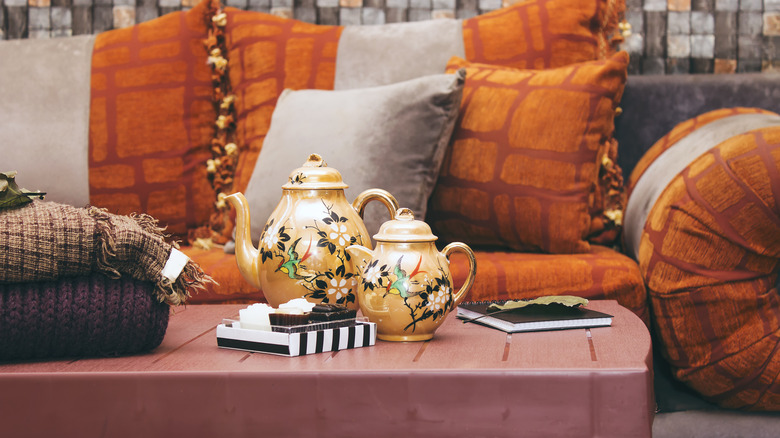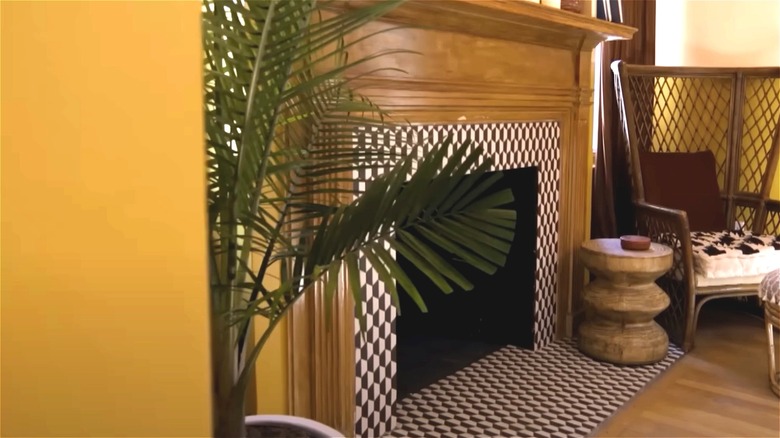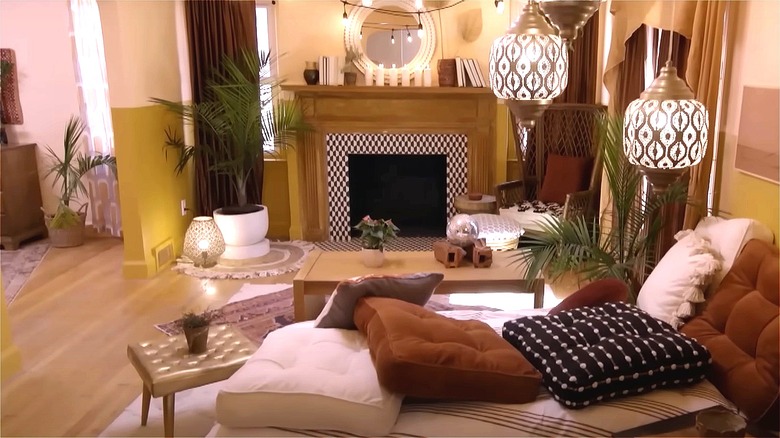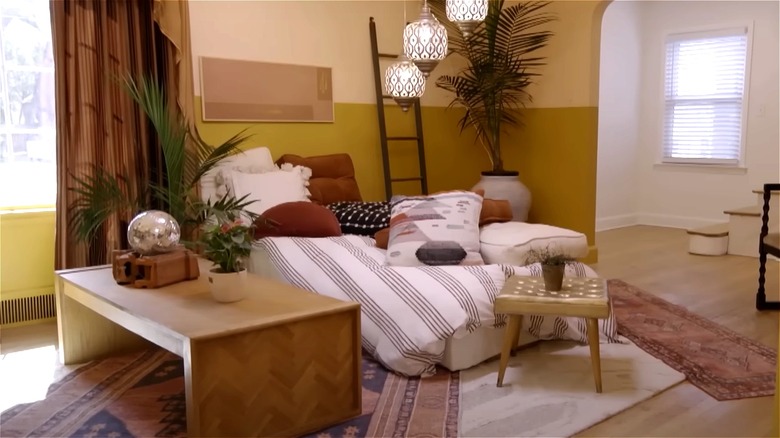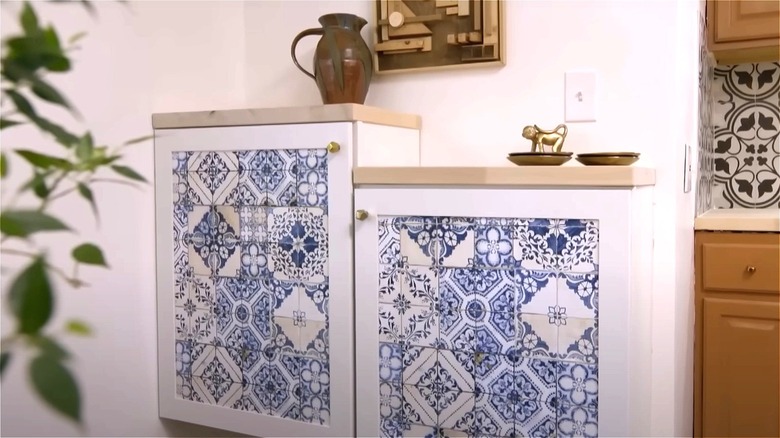Design The Perfect Moroccan-Style Home With These Bargain Block-Inspired Ideas
We may receive a commission on purchases made from links.
Interior design typically pulls elements from a variety of places. Each country in the world has its own unique take on their own decorating style, and taking inspiration from those traditional looks can add interesting elements to a home's appearance. On Season 2, Episode 7 of HGTV's "Bargain Block," co-hosts Keith Bynum and Evan Thomas were inspired by signature elements of the Moroccan style for the renovation. If you love the look they created, there are plenty of ways to add touches of this style to your own house.
Many Moroccan-inspired homes use vibrant colors and geometric patterns throughout their designs. You can see these elements used in the furniture as well as the textiles like rugs and pillows and the decor like lighting and tiles. The space the pair designed on "Bargain Block" is bold from the second you walk in the door. "This type of style is allowing Keith to go his full maximalist self," Thomas says in a clip from HGTV's YouTube channel, and Bynum agrees. With the variety of colors, interesting patterns, and unique decorative details, this style is perfect for anyone who loves designs that are eye-catching but grounded by earthy elements. Further, you don't have to be a total maximalist to incorporate Moroccan style, as many of the details are a great way to add some subtle texture or visual interest.
Include patterned tiles
An easy and fun way to incorporate Moroccan style into your home is with patterned tile. "Morocco is known for its wild tile," Keith Bynum says when choosing tile for the fireplace surround, per HGTV's YouTube channel. Moroccan types feature geometric forms like squares, diamonds, triangles, stars, and polygons that are tessellated to create intricate mosaics. These tiles are traditionally referred to as zellij and are one of the biggest artistic and cultural identities of Morocco. Traditional and authentic zellij tiles are made by hand using natural clay from the Fez region of Morocco.
Authentic Moroccan tiles purchased from the source can be expensive, but there are some fabricated stateside types that cost less. Further, Moroccan tile can come in a black-and-white color scheme, like the one Bynum chose for the fireplace surround. However, they can also have more vibrant colors, such as blues, greens, reds, and oranges. For instance, the Mini Star & Cross tile from Fireclay Tile is a stunning and colorful option that costs $40 per square foot. If you want something that's renter-friendly and easy to install, check out Jacklove's Moroccan Style Tile Stickers that cost under $14 for 25 pieces on Amazon. On top of surrounding a fireplace, add Moroccan tiles to the backsplash in the kitchen or the shower walls in the bathroom. For a larger statement, use them on the floor of an entryway, kitchen, bathroom, or laundry room.
Use bold colors and textures
Throughout Keith Bynum and Evan Thomas' design, there are plenty of colors and textures. The living room walls are painted a saffron yellow on the lower half, adding a pop of color while keeping the room bright and open. Bold, earth-toned shades are the best to use if you want Moroccan inspiration in your home. Deep reds, oranges, blues, and greens are all common, while neutral browns and tans help to ground the space.
The home also features plenty of texture with macrame, drapery, rugs, and table runners. A Moroccan rug would be a stunning focal point in any room because of the intricate patterns that reflect nature and the eye-catching colors. Many rugs include star, diamond, and flower motifs in their designs. If you're looking for the ideal piece, Safavieh's Vintage Hamadan rug in red, which is 8 by 10 feet, costs about $500 on Rugs Direct.
You can also bring in both color and texture with lush drapery to frame the windows. Macrame adds a decorative accent and can be used as wall hangings or to hold plants, as Bynum does. Find table runners that use Moroccan motifs to place on dining room tables, such as Hosnye's Moroccan Floral Table Runner on Amazon that costs about $13. Inlay wood furniture is also common in Morocco and creates a beautiful accent as a coffee or console table.
Create a Moroccan lounge living room
Instead of a traditional Western sofa, Keith Bynum decided to add a sofa bed in the living room. "I didn't know that I needed a mattress in the middle of my living room, but I love it, and it's fun," Bynum says in the YouTube clip from HGTV. Instead of placing the mattress directly on the floor, Evan Thomas creates a platform using wood pallets to raise it. They place a mattress on top and use the white sheet to cover the pallet base. Then, they pile pillows in a variety of sizes, colors, and textures that feature tassels, fringe, and embroidery on top. This creates a casual lounge space that works in place of a sofa.
Another detail that makes this living room a lounge space is the hanging lantern lights on the ceiling. Not only do these add the Moroccan touch, but they also add an interesting pattern thanks to the lampshades. For instance, you could use the Aberdeen Wide Mini Pendant that costs about $200 from Build or the Vintage Antique Moroccan Golden Lantern from Etsy seller InfinityCraftsNagri that costs about $160. These will add texture and scattered light to your home, and you could add them in the living room, the entryway, or over the dining room table.
Add pattern to your kitchen cabinets
Moroccan style is marked by bold patterns, which is why Keith Bynum added a patterned wallpaper to some of the kitchen cabinets. This adds a pop of color and cements the Moroccan style in the home. With Moroccan-inspired wallpaper, you can look for the same motifs that are featured in tile, such as arabesques, diamonds, stars, and crosses. The Pink Moroccan Tile Pattern Removable Wallpaper from Livette's Wallpaper is a great option, and it costs anywhere from $51 to $117 depending on the size and adhesive type you choose. The Flower Moroccan Tile Peel and Stick Wallpaper from Simple Shapes is another ideal pattern that's priced between $52 and $114.
This DIY will work best with flat-faced cabinets or shaker-style cabinets that have a flat panel between the raised sides. To complete this project, remove the doors from the cabinets and clean the surfaces. Cut the wallpaper a little larger than the surface you're applying it to. Use a rubber spatula or the included spatula tool to smooth out the wallpaper and get rid of any bubbles. Using an X-acto knife rather than a pair of scissors to cut the edges is a good way to ensure you have sharp corners.
